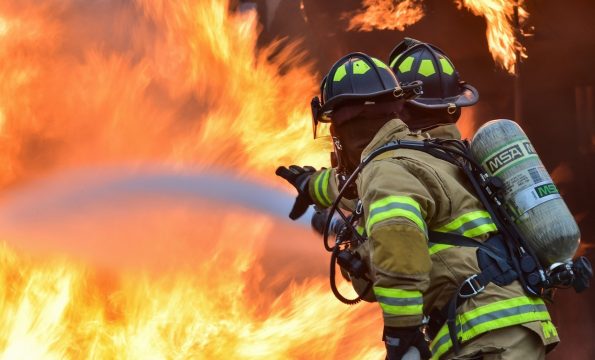“Triple-digit temperatures are fueling fast-moving, aggressive wildfires across the Golden State at a pace that far out-does that seen at this point in a typical season,” say fire experts. “More than 1,000 wildfires have been sparked in a one-week period in July — that’s more than three times the average 250 or 300 that begin each week at this point in the season, according to the California Department of Forestry and Fire Protection, or Cal Fire. Tens of thousands of more acres have burned across the state this year than at this point in 2017, which was one of the most destructive fire seasons in state history.”
More than 14,000 fire fighters are battling 17 major fires burning across the state of California. Firefighters from Australia and New Zealand are arriving to help fight them.
“A seemingly never-ending heatwave has put many cities in the state on track to set records in July — and that’s just part of the issue. Each year brings some new heat record in California, and the accumulation of year after year of sweltering summers has created dry grass, brush and millions of dead trees that spread fires at explosive rates. And this summer in particular, heat waves have exacerbated the issue.
“‘What it really means is that whatever fires get going spread more quickly and burn more intensely. So it changes the character of wildfire,’ says Daniel Swain, a climate scientist at the University of California, Los Angeles.
“Take the Carr Fire, the largest and most destructive fire of the year so far (160,000 acres burned so far). It began [three weeks ago] after a vehicle malfunction sent sparks into the foothills of the Shasta-Trinity National Forest in Northern California. But within days, the inferno exploded, spreading to the city of Redding, where it has already destroyed more than [1,600] homes and buildings and taking the lives of at least [seven] people.
“The intense heat has taken hold of Redding in particular for more than a month and a half, says Scott McLean, deputy chief of Cal Fire. A hot summer isn’t unusual, he says. It’s the consistent heat wave that is…
“By Tuesday morning, the fire scorched more than [160,000] acres, easily ranking as one of the largest fires in state history — and the blaze is [now 43%] contained. What sets the Carr Fire apart from others on that list, however, was the absence of aggressive winds that typically fuel a fast-moving fire. Instead, ‘it developed its own extreme weather conditions,’ Swain says, creating a rare ‘apocalyptic’ weather pattern that appears like a fire tornado that is fueled, in part, by extreme temperatures.”
“Another major fire also burning in Northern California, the Ferguson Fire, extended into its third week. This fire has killed two people and injured 11 others. And it prompted the indefinite closure of some of the most popular parts of Yosemite National Park, officials announced on Sunday. ‘Over the past 48 hours, fire has impacted all of the roads used to access Yosemite Valley, burning dead and downed trees that can become very explosive and fall without warning,’” the Park service said. “Of the 89,633 acres burned, firefighters have contained about 38%, according to authorities.”
“Those same temperatures have created hoards of dry brush and grass, making more fuel for a fire to burn through quickly. Intense heat has dried out the typically damp vegetation in the understory of a forest. ‘There’s nothing to stop a fire; almost everything becomes flammable when conditions are this extreme,’ says Jessica Halofsky, a fire research ecologist at the University of Washington.
“The extreme heat has also caused firefighters to change their tactics over the years. Not only are the days hotter, but, so are the nights, says Swain. Those typically cooler hours are critical in fire-suppression efforts, allowing firefighters to get closer to the flames. But the temperatures aren’t falling as much as they used to, Swain says, and ‘that does directly play into fire behavior at night.’
Rising temperatures aren’t the only reason fires have grown in size and aggression, though scientists are quick not to place blame entirely on climate change. Urban development in vulnerable areas can make fires more devastating, and many of the state’s most destructive fires were started by humans including the Carr Fire. Max Moritz, a specialist in cooperative extension at the University of California’s Division of Agriculture and Natural Resource, says hotter temperatures have made fire seasons longer, too. Scientists see a direct link between rising temperatures and the amount of dry brush and ample fuel, which makes the fires fast-moving and often more explosive.
“No matter how damp a winter may be, a hot summer could dry out or kill vegetation and become easier to burn. Last year, the state had a wet winter — a rarity that came after a several years-long drought that Gov. Jerry Brown had declared was finally over. California still experienced its hottest summer on record several months later — and saw its largest fire ever scorch Napa, Sonoma and Lake counties in Northern California. This past year, the winter was unseasonably dry, and experts say that means the 2018 fire season could grow more intense.
“‘We don’t have what we need,’ says McLean, of Cal Fire. ‘California overall needs to have several years of significant weather in the winters to bring it back on the plateau.’
“Battling these relentless fires requires a Herculean effort,” California Gov. Jerry Brown had written in his request to Trump for a presidential major disaster declaration.”
It is evident that the end is near, that the Spirit of God is being withdrawn from the world. As I read of floods and fires, cyclones and earthquakes, in different places, I know that the Lord is soon to come. Letter 54, 1902.






Comments